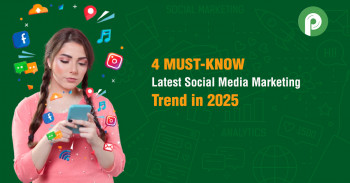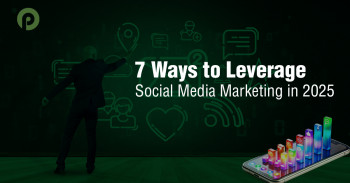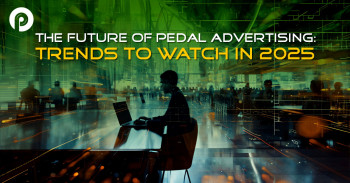Harnessing The Emotional Impact Of Advertising For Greater Success
2023-09-08 6423

The emotion attached to a product or any entity in advertising and marketing is a powerful tool that can make or break a brand. The power of emotion in advertising and marketing is undeniable. Utilizing emotion in your advertising and marketing campaigns can create stronger connections with your audience and drive greater success. Research has shown that when people are emotionally engaged with an advertisement, they are more likely to remember and act upon it.
Similarly, in the digital marketing era, emotional branding has become even more important. With the rise of social media and online platforms, brands have more opportunities than ever to connect with consumers on an emotional level. Digital marketing in Nepal, for example, has seen brands leverage emotional storytelling to engage with their target audience effectively.
From understanding the basics of emotion in advertising to learning how to use it to reach your target audience, this blog post will provide an overview of how to effectively use emotion in advertising to make a lasting impact. We'll look at examples of successful campaigns and discuss the importance of understanding emotion in order to craft effective, emotionally resonant advertising.
The Power of Emotions in Advertising
Emotion in advertising and emotion in marketing are crucial elements that can make a huge impact on how consumers perceive and interact with a brand. Emotions have a powerful impact on our decision-making processes. They play a significant role in advertising and marketing, as they can evoke strong feelings and connections with consumers. The use of emotion in marketing is not a new concept, but it has gained even more importance in the age of digital marketing.
In today's fast-paced world, where consumers are bombarded with advertisements from all directions, capturing their attention is crucial. This is where emotions come into play. By appealing to consumers' emotions, advertisers can create a strong connection with their target audience, making their brand more memorable and increasing the likelihood of a purchase.
The use of emotion in digital marketing is particularly important. In Nepal, digital marketing is rapidly growing, and businesses are constantly looking for effective strategies to stand out in the digital landscape. Incorporating emotion into digital marketing campaigns can make a significant impact on consumer behavior.
One of the most effective ways to harness the power of emotion in digital marketing is through storytelling. By telling a compelling story that evokes specific emotions, businesses can create a lasting impression on their target audience. For example, during a campaign for a business that (Aja Dynasty) made souvenirs for tourists and other people to buy, we emphasized entirely promoting products as ‘made in Nepal’. This allowed us to harness a nostalgia-of-sorts kinda emotion to the brand that could tell the story of an individual or cultural group who has overcome adversity, inspiring people to buy something that represents Nepal.
Additionally, leveraging emotional triggers in advertisements can also lead to greater success. Emotions such as happiness, sadness, fear, and excitement can all be used strategically to elicit desired responses from consumers.
The Science Behind Emotional Advertising
Emotional advertising has become an integral part of marketing strategies, and understanding the science behind it can provide valuable insights into consumer behavior. The use of emotions in advertising is not merely about making people feel something, but rather tapping into the cognitive processes that drive decision-making.
Research has shown that emotions play a key role in our memory and attention. When an advertisement elicits a strong emotional response, it is more likely to be remembered and have a lasting impact on consumers. This is because emotions activate the limbic system in our brains, which is responsible for processing emotions and creating memories.
Furthermore, emotions also influence our decision-making processes. When we are emotionally engaged with an advertisement, we are more likely to take action. This is because emotions have a direct impact on our behavior, driving us to seek pleasure, avoid pain, or fulfill our needs and desires.
In the context of digital marketing in Nepal, understanding the science behind emotional advertising becomes even more crucial. With the rapid growth of digital marketing, businesses need effective strategies to stand out in the crowded digital landscape. Incorporating emotions into digital marketing campaigns can help capture the attention of consumers and drive them to engage with the brand.
By leveraging the science of emotions, marketers can strategically design their advertisements to evoke specific emotional responses. Whether it's creating a sense of joy, nostalgia, or fear, understanding how emotions work can help marketers create compelling and persuasive advertisements.
In summary, the science behind emotional advertising is rooted in understanding how emotions influence memory, attention, and decision-making. By tapping into the power of emotions, businesses can create more memorable and effective advertising campaigns in the digital marketing landscape of Nepal.
Types of Emotions Used in Advertising
Emotions are a powerful tool in advertising, and understanding how to effectively utilize different types of emotions can make a significant impact on the success of marketing campaigns. In the realm of emotion in marketing, there are several key emotions that advertisers commonly tap into to create connections with consumers.
One of the most frequently used emotions in advertising is happiness. By evoking feelings of joy, advertisers can create a positive association with their brand or product. For example, a cereal company like WellBell requires healthy people or a scene of a happy healthy family laughing and enjoying themselves while enjoying product, creating a sense of happiness and promoting health.
Sadness is another emotion that can be effectively used in advertising. By creating a sense of empathy and compassion, advertisers can tug at the heartstrings of consumers and encourage them to take action. This emotion is often employed by charity organizations to highlight the plight of those in need and inspire viewers to donate.
Excitement is another emotion commonly used in advertising. By creating a sense of anticipation and thrill, advertisers can generate interest and engagement. This emotion is often utilized in industries such as travel and entertainment, where advertisers aim to evoke a sense of wanderlust or eagerness for new experiences.
In the context of digital marketing in Nepal, understanding the types of emotions that resonate with consumers is crucial. Different cultural nuances and preferences may influence the effectiveness of certain emotions in advertising. Advertisers need to research and understand their target audience to ensure that the emotions they utilize in their campaigns are appropriate and effective.
Emotional Advertising Case Studies
Emotional advertising has proven to be a powerful tool for brands to connect with their target audience on a deeper level. To further understand the impact of emotions in advertising, let's explore a few case studies that showcase the effectiveness of emotional advertising in different industries.
1. Coca-Cola's "Share a Coke" Campaign: In 2011, Coca-Cola launched a campaign that personalized its iconic bottles and cans with popular names and terms of endearment. The campaign aimed to evoke feelings of happiness, nostalgia, and personal connection. By using emotions as the centerpiece of their campaign, Coca-Cola successfully created a sense of joy and camaraderie among consumers, resulting in increased sales and brand loyalty.
The campaign was a huge success, with consumers across the globe sharing photos of their personalized bottles and cans on social media. The campaign also generated a great deal of positive press coverage, further reinforcing Coca-Cola's position as a beloved brand.
The campaign's success is a testament to the power of emotions in marketing. By tapping into consumers' emotions, Coca-Cola was able to create a truly memorable and effective campaign that resulted in significant business results.
2. Vatsalya’s "सम्भव छ (it's possible)" Campaign: Vatsalya, an IVF clinic in Nepal aimed to change the health care scenario of Nepal by encouraging people to pursue IVF care in Nepal rather than going abroad for treatment. Being an IVF clinic it became relatively easy for Vatsalya to emphasize emotions that held an uncertain but promising future. Thus the campaign that spoke loudly that it was possible to have babies even if you are facing fertility-related issues became a success as it promised hope. Through emotional storytelling and real-life testimonials, Vatsalya was able to strike a chord with many people with fertility problems leading to increased brand trust and positive brand perception.
3. TATA Nexon’s "Women Drive Nation" Campaign: TATA a vehicle manufacturing company, distributed by Sipradi Trading in Nepal, launched a campaign “Women Drive Nation” promoting their electric vehicle during Miss Nepal event. With women in the front, it was able to spread a bigger message of breaking the stereotype of women’s driving. The campaign was able to spark conversation about gender stereotypes and received widespread acclaim.
These case studies demonstrate the power of emotional advertising in creating strong connections and influencing consumer behavior. By tapping into the emotions of their target audience and addressing societal issues, these brands were able to stand out and make a lasting impact. When done effectively, emotional advertising has the ability to not only drive sales but also foster positive brand perception and create a loyal customer base.
How to Harness Emotional Advertising for Greater Success
Emotional advertising can be a powerful tool for creating a lasting impact on your target audience. But how can you effectively harness the power of emotions to drive greater success in your advertising campaigns? Here are some strategies to help you do just that.
Firstly, it's essential to understand your target audience and their emotional triggers. Conduct thorough market research to gain insights into the emotions that resonate with your audience. What are their fears, desires, and aspirations? By understanding their emotional needs, you can tailor your advertising to evoke the right emotions and create a deeper connection.
Next, storytelling is a highly effective technique for harnessing emotional advertising. Craft compelling narratives that elicit specific emotions and engage your audience on an emotional level. Use relatable characters, real-life scenarios, and impactful visuals to evoke the desired emotions. For example, a healthcare brand could tell the story of a person's journey to recovery, inspiring hope and empathy in viewers.
Additionally, authenticity is crucial in emotional advertising. Consumers are becoming more discerning and crave genuine connections. Avoid overly staged or manipulative tactics, as they can come across as insincere. Instead, focus on genuine human experiences and stories that resonate with your audience's emotions.
Furthermore, leveraging social media platforms can amplify the emotional impact of your advertising. These platforms allow for immediate and direct engagement with your audience. Create content that sparks conversations and encourages user-generated content. For example, you could ask your audience to share their own stories or experiences related to your brand, further strengthening the emotional connection.
Lastly, regularly analyze and measure the impact of your emotional advertising campaigns. Use data and metrics to assess the effectiveness of different emotions, storytelling techniques, and platforms. Adjust your strategies accordingly to optimize your campaigns and achieve greater success.
The Ethics of Emotional Advertising
Advertising is a powerful tool that can elicit strong emotions in consumers. While emotional advertising can be highly effective, it is essential to consider the ethics behind it. The ethical implications of emotional advertising revolve around the responsibility advertisers have to their audience and the potential manipulation of emotions for financial gain.
One of the key ethical concerns in emotional advertising is the potential for manipulation. By deliberately evoking specific emotions, advertisers can influence consumer behavior and decision-making. This raises questions about the authenticity and honesty of the advertisement.
Are advertisers being transparent about their intentions, or are they simply exploiting emotions for their own gain? It is crucial for advertisers to strike a balance between creating emotional connections and being truthful about their products or services.
Another ethical concern is the potential harm that emotional advertising can cause. Certain emotions, such as fear or sadness, can have a profound impact on individuals, especially when exploited in advertising. For example, using fear tactics to sell a product can create unnecessary anxiety or stress in consumers. Advertisers need to consider the potential negative consequences of their emotional appeals and ensure that they are not exploiting vulnerable individuals or triggering trauma.
Transparency and honesty are key ethical principles that should guide emotional advertising. Advertisers should clearly communicate the intended emotional impact of their advertisements and avoid manipulating emotions solely for financial gain. It is also important to consider the long-term effects of emotional advertising. Will the emotions evoked in the advertisement have a positive or negative impact on the consumer's well-being?
Ultimately, emotional advertising should aim to create genuine connections and positive experiences for consumers. Advertisers have a responsibility to be ethical in their approach, considering the potential impact on individuals' emotions and overall well-being. By being transparent, responsible, and empathetic, advertisers can harness the power of emotions in a way that benefits both their brand and their audience.
Emotional Branding
Emotional branding is a marketing strategy that aims to create a strong emotional connection between a brand and its consumers. It goes beyond simply promoting products or services and focuses on creating a memorable and meaningful experience that resonates with the target audience.
In emotional branding, brands tap into the power of emotions to capture the attention and loyalty of consumers. By evoking emotions such as happiness, joy, nostalgia, or even sadness, brands can create a deeper connection with their audience, making their products or services more relatable and memorable.
One of the key elements of emotional branding is storytelling. Brands use narratives, visuals, and music to tell stories that engage and captivate the audience on an emotional level. These stories can take various forms, such as short films, commercials, or social media campaigns. By telling a compelling story, brands can elicit emotional responses from consumers, which in turn can drive engagement and ultimately lead to increased sales.
Your journey with Pedal
For anyone looking to establish their business or brand with a bang, you can trust Pedal Advertising and Digital Marketing to take your business to the heights you imagined it will achieve. While running an impeccable social media campaign has always been our strongest suit we are not that far behind when it comes to branding and creating a safe environment for any business to flourish.
One thing that sets Pedal Advertising and Digital Marketing apart from other marketing agencies worldwide is that we always value and promote the solution any product provides rather than the product itself. We don’t just sell your product, we promote the experience according to the needs of your targeted customers. Our process may seem a little unorthodox but nothing beats doubts than mouth-watering results in just a matter of time. We believe in the process and we owe everything to the process of our work for the success we have seen in a very short amount of time.
Pedal Group is one of the Top Digital Marketing Agency in Nepal helping you establish your business as an authority with informative, targeted content with a strategy that follows your audience and boosts your SEO efforts even further on the digital media.
We aim to disseminate what we know in subjects relating to integrated marketing including digital marketing, advertising, content creation and marketing, public relations, branding, event management, web solutions, video/photography, corporate social responsibility, etc. that might help you remain informed. Drop in your feedback. We are happy to improve; always!




